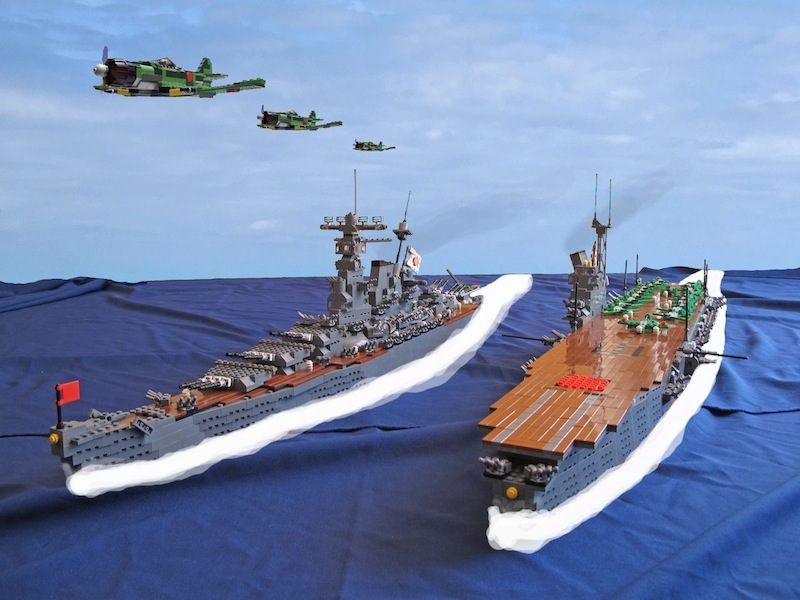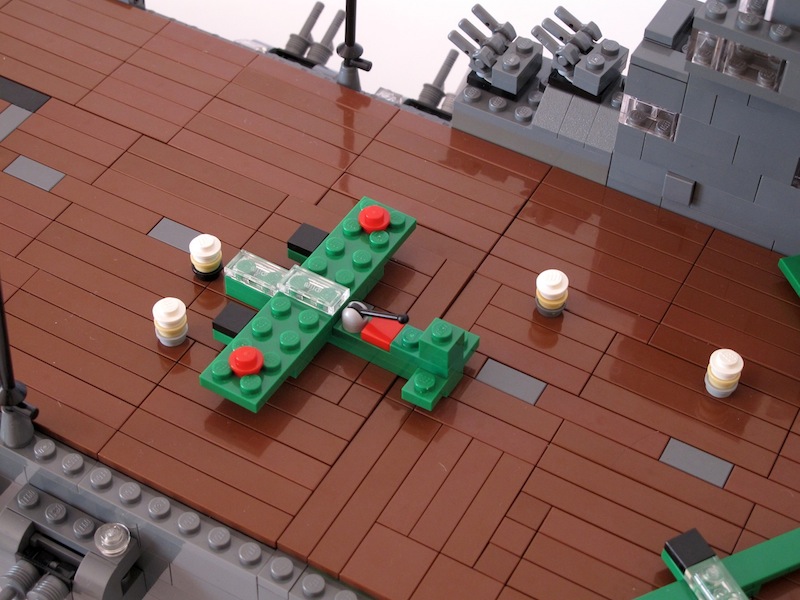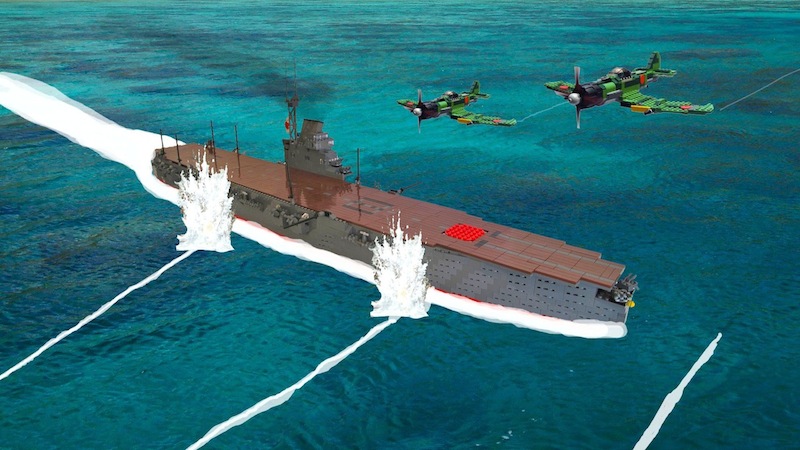I´m currently preparing a large Diorama about the Second Battle of Tsushima, between Japan and Russia in 1947.
Although this “What-If” story takes place in 1947, Japan is at war with Russia and not the United States (which actually supports Japan during this conflict). The Second World War never happened and jet aircraft is still a thing of the future.
More pictures here:
http://www.flickr.com/photos/einon/Aircraft Kirin
Above, the large Aircraft Carrier Kirin, escorted by the Battleship Iburi (armed with 12 406mm (16") guns).
The “What-if” Story:
During the invasion of China in 1937, the light aircraft carrier Karuma got hit by five 500kg bombs dropped by nationalists Tupolevs SB bombers, which in a matter of minutes pierced the flight deck and exploded on the hangar (not flash or vapor tight and poorly ventilated) destroying all aircraft (fully fuelled and armed!) waiting there. Poorly trained damage-control teams didn’t help either, and so the Aircraft Carrier sunk within a matter of two hours with heavy loss of life.
With the danger of a Second Russo Japanese war on sight, construction of the two huge Kirin aircraft carriers was started in 1942, both becoming operational in 1945 (therefore, two years before the Second Russo-Japanese War began). Built with help of technicians from the USA and the Weimar Republic (Germany), they were by far the largest warships in the world at the time, with a length of 302meters.
Two ships were built; Kirin and Mizuchi, the later having a portside island which in service proved a failure and was never repeated again.
Fast (34 knots), these two ships were built without any treaty limitations, therefore they were heavily protected with a 120mm armoured flight deck and two hangars (typical on the Japanese Aircraft Carriers).
The Japanese were able to understand their mistakes with the Karuma and designed all their new aircraft carriers with strong and though armour. Everything was made to defend the new ships against torpedos and heavy weight bombs. Fuel tanks and the magazines were also strongly protected. Damage control teams also became a lot better after the experience with Karuma and radar as installed on almost all ships to help detect approaching bombers. The name Karuma was later given to another aircraft carrier.
With lots of space, two very spacious hangars, two elevators and planes equipped with folding wings, the Kirins were capable of carrying (at least in theory) 120 aircrafts (30 of them dismantled), although an air group of 98 planes was more common (40 fighters, 30 dive-bombers, 24 torpedo-bombers and 4 scout planes equipped with in board radar). American doctrine of parking aircraft on the flight deck was also employed, therefore allowing extra aircraft to be carried.

The Kirins were so large that medium bombers like the Mitsubishi G4M “Betty” bomber could operate from it! Equipped with folding wings and powerful engines, this configuration gave the Japanese Carriers a far more menacing capacity. The medium bombers could also be employed as Awacs or refuel other aircrafts. Since Medium bombers required a large runway to take off, the ship received two very powerful catapults.
The ship also had sixteen 127mm AA (anti-aircraft) guns and at least 120 47mm Auto-cannons in 40 triple positions (although some extra weapons were added later). Thanks to the Americans, the Kirins also had advanced radars to detect the enemy Russian aircrafts approaching. The Type 27U radar (U from “USA”) was capable of detecting a group of aircrafts at more than 180miles and a single aircraft at 126miles. Russian radars built in Britain at the time were slightly more accurate and advanced.
Operational story:
The two ships became operational in 1945 and for the next two years they were mostly used on trainings and naval exercises. On November 24, 1946, a 1000kg bomb fell by accident from a bomber parked on the flight deck of Kirin, exploding and producing a large hole on the armoured deck; then a series of massive explosions produced more and more damage. However the ship Damage-Control crew was alert and after a 2 hours hard battle against the fire, the ship was eventually saved. The fire destroyed and buckled more than 60% of the flight deck with at least 24 planes and 210 crew men lost; the hangar roof below the fire also become slightly deformed from the heat. However after 4 months of repair, the ship was again operational, with many more lessons learn. More protection was therefore given to both ships.

With the start of the Second Russo Japanese War, these heavily armed carriers were mostly used as forward floating fortresses, being able to land and refuel/rearm aircrafts from less protected carriers operating to the rear.
After a series of special missions performed during the 32 days Second Russo-Japanese war, the two ships were sent to the Second and last Battle of Tsushima.
It’s widely accepted that there are lucky and unlucky ships, and Mizuchi was a lucky ship.
Just a few moments after launching all their planes against the far larger Russian fleet at the Tsushima strait, the Russian submarine S-45 fired 4 torpedos against the Mizuchi and two of them hit the huge carrier. Rapid reaction from the Damage Control teams and counter-flooding measures prevented the ships from sinking. The ship, still moving at high speed and with a damaged bow, took on so much water that it nearly capsized!
The Russians, believing that the aircraft carrier had been sunk got relaxed after the news transmitted by the S-45… They would have a great surprise shortly after…
Info:
Type: Heavy Aircraft Carrier
Number of ships completed: 2 (Kirin and Mizuchi)
Operational: 1945
Displacement: 89 000tons
Dimensions:
Length: 302meters
Beam: 43meters
Draft: 12 meters
Maximum speed: 34knots
Radius: 14 000km
Crew: 2 656
Armament:
16 127mm AA guns in 8 double turrets
120 47mm AA automatic cannons on 40 triple turrets
Armour: 120mm armoured flight deck; 200mm sides of the hangar; 250mm side armour.
Aircraft: (maximum: 120)
Hope you like it!
More pictures here:
http://www.flickr.com/photos/einon/Eínon